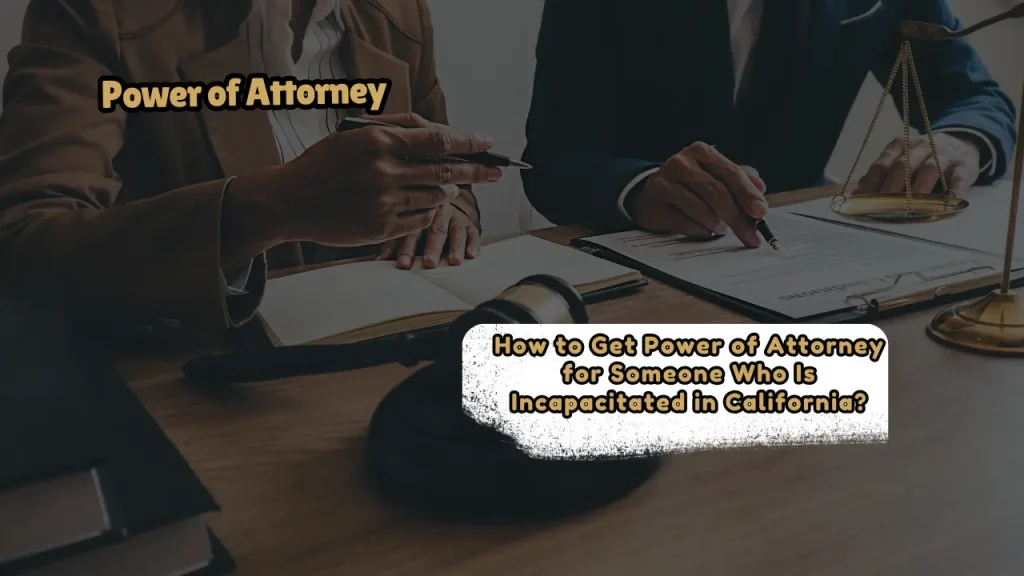How to Get Power of Attorney for Someone Who Is Incapacitated in California?
If someone is already incapacitated in California, you cannot obtain a standard power of attorney because it requires the principal to be mentally competent at the time of signing. Instead, you’ll need to petition the court for conservatorship, which grants you legal authority to make decisions on their behalf. However, if a durable power of attorney or advance healthcare directive was established before their incapacity, the designated agent can act without court intervention.
In California, getting power of attorney for someone who is already incapacitated isn’t as straightforward as signing a document. But don’t worry—there’s a clear path forward. In this guide, we’ll walk you through the process, explain your options under California law, and help you take action to protect your loved one. (If you’re looking for general information on this topic, check out our previous article on How to Get Power of Attorney for a Family Member. Here, we’ll focus on California-specific steps.)
Table of Contents
The Stakes: Why Acting Fast Matters in California
Without a durable POA or advance directive in place, you could face:
- Frozen Assets: Banks may lock accounts, leaving bills unpaid.
- Delayed Medical Care: Doctors may hesitate without clear consent.
- Court Battles: Family disputes over who should take charge can drag out the process.
In California, the court system handles over 50,000 active conservatorship cases, per the California Courts. While conservatorship offers a solution, it’s time-consuming and costly—making it crucial to explore all options.
How to Get Power of Attorney for an Incapacitated Person in California: Your Roadmap
Step 1: Check for an Existing Durable POA or Advance Directive
Before heading to court, search for any existing documents. California recognizes:
- Durable Power of Attorney for Finances: Allows the agent to manage financial affairs.
- Advance Healthcare Directive: Appoints an agent for medical decisions.
If these exist and name you (or someone else) as the agent, you may not need court intervention. Check with your loved one’s attorney or look in their personal files.
Pro Tip: In California, POAs can be registered with the county recorder’s office, though it’s not required. Start your search there if needed.

Step 2: Understand Conservatorship as the Alternative
If no durable POA exists, you’ll need to petition for conservatorship. Under the California Probate Code (Sections 1800-1972), conservatorship allows a court-appointed individual (the conservator) to manage the affairs of an incapacitated adult (the conservatee). There are two main types:
- Conservatorship of the Person: For healthcare and personal decisions.
- Conservatorship of the Estate: For financial matters.
You can petition for one or both, depending on the situation.
Step 3: File a Petition with the Superior Court
To start the process:
- Determine the Type: Decide if you need a general conservatorship (broad authority) or a limited conservatorship (for adults with developmental disabilities).
- File the Petition: Submit forms to the Superior Court in the county where the proposed conservatee lives. Key forms include:
- GC-310: Petition for Appointment of Probate Conservator.
- GC-020: Notice of Hearing.
- Pay Filing Fees: Expect to pay around $435, though fee waivers are available for low-income petitioners.
Step 4: Provide Notice and Gather Evidence
California law requires you to:
- Notify Relatives: Send formal notice to the proposed conservatee’s spouse, children, and other close relatives.
- Prove Incapacity: Submit medical documentation, such as a Physician’s Declaration, confirming the person’s inability to make decisions.
Additionally, the court will appoint an investigator to assess the situation and ensure the proposed conservatee’s rights are protected.
Step 5: Attend the Court Hearing
At the hearing:
- Present Your Case: Explain why you’re the best person to serve as conservator.
- Address Concerns: The judge may ask about your plans for managing the conservatee’s care or finances.
- Legal Representation: The proposed conservatee must be represented by an attorney. If they can’t afford one, the court will appoint a public defender.
Step 6: Fulfill Ongoing Responsibilities
If appointed, you’ll need to:
- Post a Bond: For estate conservatorships, this acts as insurance against mismanagement.
- File Reports: Submit annual accountings to the court detailing financial transactions or care decisions.
This oversight ensures transparency but adds complexity compared to a POA.
Conservatorship vs. POA: Key Differences in California
- Power of Attorney: Set up privately before incapacity; no court involvement.
- Conservatorship: Requires court approval; public and more expensive.
Legal fees for conservatorship can range from $3,000 to $10,000, according to the California Bar Association, while a POA typically costs $200-$500.
Special Considerations in California
- Temporary Conservatorship: For urgent situations, you can request a temporary conservatorship, which can be granted in as little as 5 days.
- LPS Conservatorship: For individuals with severe mental illness, governed by the Lanterman-Petris-Short Act.
- Developmental Disabilities: Limited conservatorships are available for adults with conditions like autism or cerebral palsy.
Choosing an Agent or Conservator: What to Consider
Whether you’re setting up a POA in advance or petitioning for conservatorship, choose someone who is:
- Trustworthy: They’ll have significant legal authority.
- Organized: Managing finances or healthcare requires attention to detail.
- Local: California courts prefer conservators who live nearby to ensure accessibility.
Wrapping Up: Take Action Before It’s Too Late
Securing power of attorney for an incapacitated loved one in California isn’t simple—but it’s doable. Whether you’re activating an existing durable POA or managing the conservatorship process, the key is to act swiftly and seek legal guidance.
The best advice? Plan ahead. Encourage your loved ones to set up a durable POA and advance healthcare directive while they’re still capable. For those already facing incapacity, don’t delay—start the conservatorship petition today.
About the Author

Sarah Klein, JD, is an experienced estate planning attorney who has helped clients with wills, trusts, powers of attorney, and probate matters. At All About Lawyer, she simplifies complex estate laws so families can protect their assets, plan ahead, and avoid legal headaches during life’s most sensitive moments.
Read more about Sarah
